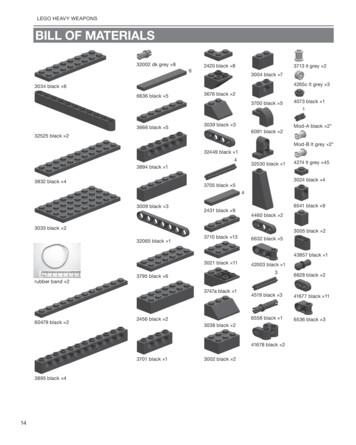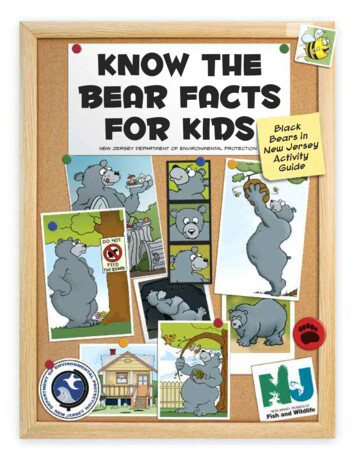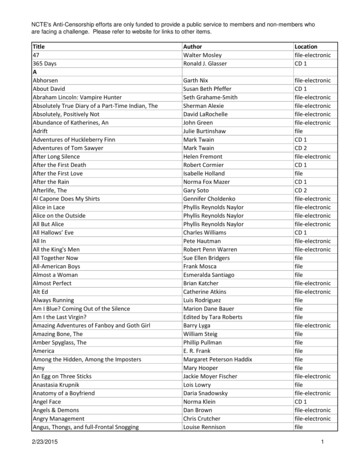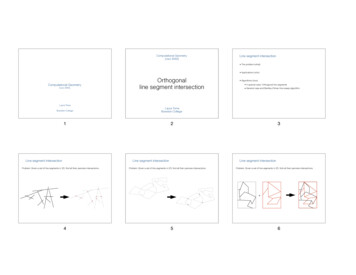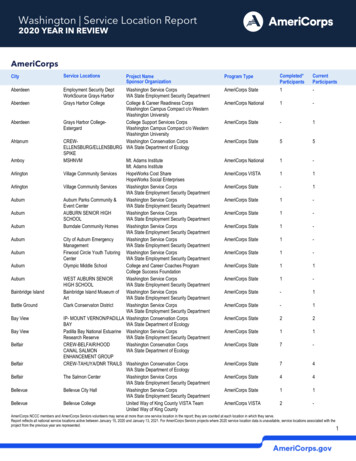
Transcription
Black BearsAmerican black bears (Ursus americanus, Fig.1) are the most common and widelydistributed bears in North America. InWashington, black bears live in a diverse arrayof forested habitats, from coastal rainforeststo the dry woodlands of the Cascades’ easternslopes. In general, black bears are stronglyassociated with forest cover, but they dooccasionally use relatively open country, suchas clearcuts and the fringes of other openhabitat.Figure 1. The American black bear is the most common and widelydistributed bear in North America.The statewide black bear population in(Washington Department of Fish and Wildlife.)Washington likely ranges between 25,000 and30,000 animals. As human populationsencroach on bear habitat, people and bears have greater chances of encountering each other. Bears usually avoidpeople, but when they do come into close proximity of each other, the bear’s strength and surprising speed make itpotentially dangerous. Most confrontations with bears are the result of a surprise encounter at close range. Allbears should be given plenty of respect and room to retreat without feeling threatened.Facts about Washington’s Black BearsFood and Feeding Behavior Black bears are omnivores. They eat both plants and animals; however, their diet consists mostly of vegetation(Fig. 2). In the spring, black bear diets consist mostly of herbaceous plants, from emerging grasses and sedges tohorsetail and various flowering plants. In summer, bears typically add ants, bees, grubs, and a host of later emerging plants to their diets. During late summer and fall, bears typically shift their diets toward tree fruits, berries, and nuts, but they stillmay consume a variety of plants. Fall is a critical season for black bears and they commonly acquire most of their annual fat accumulation at thistime. Bears may forage up to 20 hours a day during fall, increasing their body weight by 35 percent inpreparation for winter. Typically, a small proportion of the black bear’s annual diet is made up of animal matter, including insects,mice, voles, ground squirrels, fawns and elk calves, eggs, carrion (animal carcasses), and fish, but theiravailability varies and is often unpredictable. An occasional bear may take livestock. Black bears have adequate senses of sight and hearing, but their keen sense of smell and innate curiosity makethem skilled scavengers. They consume carrion when they can find it, and are notorious for taking advantageof human irresponsibility with food, garbage, and bird-feeder management. Bears will eat anything that smellsappealing and will help them prepare for their long winter sleep. Black bears move in response to the seasonal availability of food, roaming constantly throughout their homerange.
Den Sites and Resting SitesFigure 2. Black bears areomnivores. They eat both plantsand animals; however, their dietconsists mostly of vegetation Black bears den during the winter months (typically from midOctober into April) when food is scarce and the weather turnsharsh.(Oregon Department ofFish and Wildlife). Denning black bears enter a state of torpor, a modified form ofhibernation. This drowsy condition allows bears to defendthemselves (and their cubs) more effectively should a predatorvisit the den. Bears do not urinate or defecate during denning—they recycletheir waste into proteins and other nutrients. By not defecating,bears keep their dens essentially scent-free, protecting them frompotential predators like cougars. Black bears in coastal areas may remain active throughout thewinter, except for pregnant females, which den to give birth tocubs. Black bears can take up residence in small dens, some scarcely bigger than a garbage can. Den sites include treecavities, hollow logs, small caves, and areas beneath large roots, stumps, logs, and rural buildings. They’lloccasionally excavate a den in the side of a hill near shrubs or other cover. Summer beds are merely concealed places scratched in the ground among dense vegetation, by a rock, or underthe branches of a fallen tree. Young bears rest in trees for safety (Fig. 3).Reproduction and Family Structure Female black bears breed for the first time at 3½ to 5½years of age. Mating takes place in June and July. Males compete for the right to breed, and breeding fightsbetween males may be intense. Older males frequentlyhave extensive scars on their heads and necks from fightsin previous breeding seasons. Following a gestation period of about seven months,females normally give birth to one or two cubs in thewinter den during January or February. Females have onelitter every other year. Bears have a reproductive pattern known as delayedimplantation. Following fertilization in early summer, abear’s embryo goes dormant, free-floating in the uterus.After the female dens in late fall, the embryo implants inthe uterine wall and development of the fetus proceedsrapidly. Although the total gestation time isapproximately seven months, the actual developmentalperiod for the bear fetus is less than three months. At six months, cubs are able to locate food, but generallyremain with their mother for over a year—usuallydenning with her during their second winter. Parental care is solely the responsibility of females; malessometimes kill and eat cubs.Figure 3. Young bears rest in trees for safety(Oregon Department of Fish and Wildlife).
Mortality and Longevity Other than humans, black bears have few predators—cougars, bobcats, and coyotes attack cubs if given theopportunity. Male bears may eat cubs. In the year 2005 hunters harvested 1,333 black bear inWashington. Female black bears have the potential to live into theirFigure 4. The hind feet of anadult black bear average 7 to9 inches long by 3 to 5 incheswide; the front feet are 4 to 5inches long by nearly thesame width.(Drawing by Kim A.Cabrera.)mid 20s. Male black bears do not typically live as long,rarely attaining 20 years of age.Viewing Black BearsExcept for females with cubs, black bears are usuallysolitary animals. Depending on their food supply, theymove about during the day or night. In late summer andfall, feeding keeps them active throughout the day so theycan gain the weight needed for winter. When bears find ahuman food source, their schedule may change. If they are receiving handouts they can be most active at midday; ifthey are feeding at dumps or trashcans, they become active at night.Black bears should be treated with respect and safely observed from a distance of at least 100 yards. This isespecially important with females accompanied by offspring, as mother bears are very protective of their young.TracksAll black bear prints usually show five digits (Fig. 4). The toes form a rough semicircle in front of each foot, withthe middle toe being the longest. Front foot tracks have small footpads, whereas hind foot tracks characteristicallyshow an extended footpad, resembling a human foot. The claw marks are about ½ inch in front of the toe pads,but often the claw marks do not show in a track.DroppingsWhen plants, insects, and animal carcasses make up most of a bear’s diet, its droppings are cylindrical and typicallydeposited in a coiled form, sometimes in individual segments. Segments are 2 to 3 inches long and 1¼ to 1½inches in diameter. Bits of hair, fur, bone, insect parts, and plant fibers distinguish these droppings from humanfeces, as does the large size of the deposit. Color ranges from dark brown to black, and when grasses are beingheavily eaten droppings are often green. When fruits and berries are in season, droppings assume a moist,“cowpie” form and seeds are visible.Bear TreesBlack bears commonly leave a variety of marks on trees. Because young bears often climb trees, trees in high beardensity habitats will show the telltale claw marks and hairs indicating that a bear has previously climbed the tree.On young conifers, particularly Douglas-fir trees, bears will rip strips of bark off with their teeth to reach insectsor the sweet-tasting sap found inside (Fig. 5). The bear’s teeth leave long vertical grooves in the sapwood and largestrips of bark are found around the bases of trees they peel. These marks are typically made from April to July, butthe results may be seen all year. This foraging activity is common in tree plantations where large stands of trees aresimilarly aged and of a single species.A bear may also rub its back against a tree or other object. Rubbing is a favorite summer pastime among blackbears, relieving the torment of parasites and loosening their thick, matted winter coat. Good scratching trees maybe used repeatedly for several years, and are easily identified by the large amounts of long black or brown furcaught in the bark and sap. Rough-barked trees often serve as rubbing posts.
It has been debated whether bears mark trees to conveysocial information akin to territorial marking in othercarnivores. Such marks are most easily seen on smoothbarked species of trees—alder, aspen, birch, and whitepine—on which tooth and claw marks will contrast mostvisibly, but any live or dead standing trees may be heavilychewed. Human structures such as utility poles,footbridges, and even outbuildings may also be chewed.Feeding AreasRotting logs and stumps are commonly turned over andtorn apart to get at fat-rich grubs, ants, termites, worms,and spiders. A bear will also knock the top of an anthill orbeehive off to get to the insects.Black bears may break off entire limbs of fruiting trees,such as apple and chokecherry, to reach the fruit.Huckleberries and other fruiting shrubs may show signs ofbeing crushed under a bear’s feet. Bears may also dig forthe starchy roots of some plants, to excavate seed caches ofsquirrels and mice, and to capture mice, voles, and groundsquirrels. Evidence of digging ranges from well-definedholes to large areas that appear to have been rototilled.Bear EncountersBears tend to avoid humans. However, human-habituatedbears are bears that, because of prolonged exposure topeople, have lost their natural fear or wariness aroundpeople. Human-food-conditioned bears are those thatassociate people with food. Such bears can becomeaggressive in their pursuit of a meal.Do everything you can to avoid an encounter with any bear.Prevention is the best advice.Figure 5. Marks on trees made by black bears varyIf you are recreating in bear country, always remember:from claw marks left by climbing to peeling andNever travel alone, keep small children near you at allbiting left when larger bears (generally females) feedtimes, and always make your presence known—simplyon insects and sap found under the bark.talking will do the trick. Most experts recommend carrying(Oregon Department of Fish and Wildlife.)pepper spray when recreating in areas of high bear density.A pepper spray that has a pepper content between 1.3 and 2percent can be an effective deterrent to an aggressive bear if it is sprayed directly into the bear’s face within 6 to10 feet.Here are tips should you come in close contact with a bear: Stop, remain calm, and assess the situation. If the bear seems unaware of you, move away quietly when it’s notlooking in your direction. Continue to observe the animal as you retreat, watching for changes in its behavior. If a bear walks toward you, identify yourself as a human by standing up, waving your hands above your head,and talking to the bear in a low voice. (Don’t use the word bear because a human-food-conditioned bear mightassociate “bear” with food . . . people feeding bears often say “here bear.” Don’t throw anything at the bear and avoid direct eye contact, which the bear could interpret as a threat or achallenge.
If you cannot safely move away from the bear or the bearcontinues toward you, scare it away by clapping your hands,stomping your feet, yelling, and staring the animal in theeyes. If you are in a group, stand shoulder-to shoulder andraise and wave your arms to appear intimidating. The moreit persists the more aggressive your response should be. Ifyou have pepper spray, use it. Don’t run from the bear unless safety is very near and youare absolutely certain you can reach it (knowing that bearscan run 35 mph). Climbing a tree is generally notrecommended as an escape from an aggressive black bear, asblack bears are adept climbers and may follow you up a tree(Fig. 6).Bear AttacksIn the unlikely event a black bear attacks you (where actualcontact is made), fight back aggressively using your hands, feet,legs, and any object you can reach. Aim for the eyes or spraypepper spray into the bear’s face.Preventing ConflictsState wildlife offices receive hundreds of black bear complaintseach year regarding urban sightings, property damage, attackson livestock, and bear/human confrontations.Figure 6. Climbing a tree is generally notrecommended as an escape from an aggressiveblack bear, as black bears are adept climbers andmay follow you up a tree.The number one reason for conflict, (95% of the calls to offices) are the result of irresponsibility on the part ofpeople: Access to trash, pet food, bird feeders, and improper storage of food while camping make up the majorityof the calls.Secondarily, young bears (especially young males) are not tolerated by adult bears and they wander into areasoccupied by humans. Food may also be scarce in some years—a late spring and poor forage conditions may befollowed by a poor berry crop, causing bears to seek food where they ordinarily would not.If you live in areas where black bears are seen, use the following management strategies around your property toprevent conflicts:Don’t feed bears. Often people leave food out for bears so they can take pictures of them or show them to visitingfriends. Over 90 percent of bear/human conflicts result from bears being conditioned to associate food withhumans. A wild bear can become permanently food-conditioned after only one handout experience. The sad realityis that these bears will likely die, being killed by someone protecting their property, or by a wildlife managerhaving to remove a potentially dangerous bear.Manage your garbage. Bears will expend a great amount of time and energy digging under, breaking down, orcrawling over barriers to get food, including garbage. If you have a pickup service, put garbage out shortly beforethe truck arrives—not the night before. If you’re leaving several days before pickup, haul your garbage to a dump.If necessary, frequently haul your garbage to a dumpsite to avoid odors.Keep garbage cans with tight-fitting lids in a shed, garage, or fenced area. Spray garbage cans and dumpstersregularly with disinfectants to reduce odors. Keep fish parts and meat waste in your freezer until they can bedisposed of properly.If bears are common in your area, consider investing in a commercially available bear-proof garbage container. Aska local public park about availability or search the Internet for vendors.Only plant material should be placed in compost bins.
Remove other attractants. Remove birdfeeders (suet and seed feeders), which allowresidue to build up on the ground belowthem, from early March through November.Bring in hummingbird feeders at night.(Better yet: plant and bird-friendly landscapeand don’t use feeders.) Harvest orchard fruitfrom trees regularly (rotting fruit left on theground is a powerful bear attractant). If youhave bear problems and do not use your fruittrees, consider removing them. Do not feedpets outside. Clean barbecue grills after eachuse. Wash the grill or burn off smells, foodresidue, and grease; store the equipment in ashed or garage and keep the door closed. Ifyou can smell your barbecue then it is notclean enough. Avoid the use of outdoorrefrigerators—they will attract bears.Figure 7. An electric fence designed to keep bears out of an area.A five-wire electric fence has been effective at keeping adult bearsand their cubs out. If necessary, a 2-foot wide underground apronof chain-link fencing or steel mesh can be staked down andattached to the fence to keep bears from digging under the fence.If wood or other heavy-duty corner stakes are not used, the cornerposts will need to be carefully braced.Protect livestock and bees. Place livestockpens and beehives at least 150 feet awayfrom wooded areas and protective cover.(Drawing by Jenifer Rees.)Confine livestock in buildings and pens,especially during lambing or calving seasons.Livestock food also attracts bears and must be kept in a secure barn or shed behind closed doors. If bears areallowed access to livestock food, they may learn to feed on livestock. Immediately bury any carcasses or removethem from the site.Install fences and other barriers. Electric fencing can be used where raids on orchards, livestock, beehives, andother areas are frequent (Fig. 7). Electric fencing only works, however, if it is operating before conflicts occur.Bears will go right through electric fencing once they are food-conditioned and know that food is available.Bears can be lured into licking or sniffing the electrified wire by rubbing molasses, bacon grease, or peanut butteron the fence. (See “Deer” in this series for additional information on electric fences.)Traditional wire fencing can also be used as a barrier. Use heavy chain-link or woven-wire fencing at least 6 feethigh. Install 24-inch long wood or metal bar extensions at an outward angle to the top of the fence with twostrands of barbed wire running on top. If necessary, a 2-foot wide underground apron of chain-link fencing or steelmesh can be staked down and attached to the fence to keep bears from digging under the fence.Bears can be dissuaded from climbing a tree by attaching 4-foot long, 1 x 4 inch boards with 2-inch long woodscrews screwed all the way through them every 6 inches. (To prevent the board from splitting, drill pilot holes.)Attach at least four boards around the trunk of the tree using strong wire.Use temporary scare tactics. Bears can be temporarily frightened from a building, livestock corral, orchard, andsimilar places by the use of a night light or strobe light hooked up to a motion detector on a tripod, loud music, orexploder cannons. The location of frightening devices should be changed every other day. Even so, over a periodof time, bears will become accustomed to them. At this point, scare devices are ineffective and human safety canbecome a concern.Professional AssistanceWildlife offices throughout Washington respond to bear sightings when there is a threat to public safety orproperty. A sighting or the presence of a bear does not constitute a threat to property or public safety. Typically, noattempt will be made by a wildlife agency staff to remove, relocate, or destroy the animal.Problem bears can be live trapped by specially trained wildlife professionals and moved to more remote areas;however, such removals are expensive, time consuming, and seldom effective. (Once a bear has tasted human food
or garbage, it will remember the source and return again and again—bears have been known to return over 100miles to a human food source after having been relocated.) Using tranquilizing drugs on bears to facilitate removalis not without risks to bears and humans.When other methods have failed, lethal removal of problem animals may be the only alternative.Contact your local wildlife office for additional information and, in the case of an immediate emergency, call 911or any local law enforcement office, such as the state patrol.Public Health ConcernsBears are not considered a significant source of infectious diseases that can be transmitted to humans or domesticanimals. However, humans can become infected with trichinosis by eating undercooked bear meat.Legal StatusThe black bear is classified as a game animal (WAC 232-12-007). A hunting license and open season are requiredto hunt black bears. A property owner or the owner’s immediate family, employee, or tenant may kill a bear onthat property if it is damaging crops or domestic animals. You must notify your local Department of Fish andWildlife (WDFW) office immediately after taking a black bear in these situations (RCW 77.36.030).The killing of a black bear in self-defense, or defense of another, should be reasonable and justified. A persontaking such action must have reasonable belief that the bear poses a threat of serious physical harm, that this harmis imminent, and the action is the only reasonable available means to prevent that harm.Any bear that is killed, whether under the direct authority of RCW 77.36.030, or for the protection of a person,remains the property of the state and must be turned over to WDFW.Because bears’ legal status, hunting restrictions, and other information change, contact your local wildlife office forupdates.Adapted from “Living with Wildlife in the Pacific Northwest” (see http://wdfw.wa.gov/wlm/living.htm)Written by: Russell Link, Wildlife Biologist, Linkrel@dfw.wa.gov, with assistance from WDFW Biologists Rich Beausoleil andRocky Spencer.Design and layout: Peggy Ushakoff, ITT2Illustrations: As creditedCopyright 2007 by the Washington Department of Fish and Wildlife.This program receives Federal financial assistance from the U.S. Fish and Wildlife Service. It is the policy of theWashington State Department of Fish and Wildlife (WDFW) to adhere to the following: Title VI of the CivilRights Act of 1964, Section 504 of the Rehabilitation Act of 1973, Title II of the Americans with Disabilities Actof 1990, the Age Discrimination Act of 1975, and Title IX of the Education Amendments of 1972. The U.S.Department of the Interior and its bureaus prohibit discrimination on the bases of race, color, national origin,age, disability and sex (in educational programs). If you believe that you have been discriminated against in anyprogram, activity or facility, please contact the WDFW ADA Coordinator at 600 Capitol Way North, Olympia,Washington 98501.
They eat both plants and animals; however, their diet consists mostly of vegetation (Fig. 2). In the spring, black bear diets consist mostly of herbaceous plants, from emerging grasses and sedges to horsetail and various flowering plants. In summer, bears typically add ants, bees, grubs, and a host of later emerging plants to their diets.

